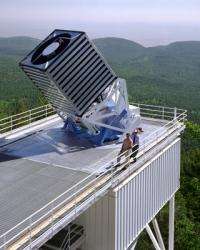Survey reveals many thousands of supermassive black holes

(PhysOrg.com) -- An international team of scientists, led by Penn State Distinguished Professor Donald Schneider, has announced its completion of a massive census in which they identified the quasars in one quarter of the sky.
The team's work is part of the Sloan Digital Sky Survey (SDSS), a nearly decade-long discovery-and-research effort using a 2.5 meter telescope located at Apache Point Observatory in New Mexico. The completed catalog of quasars, which will be published in the June 2010 issue of the Astronomical Journal, includes 105,783 quasars, more than 96 percent of which were discovered by the SDSS.
"Quasars are hundreds of times more luminous than our entire galaxy, yet they generate this tremendous power in regions similar in scale to that of our much smaller solar system," said Schneider. "The best explanation of this extraordinary phenomenon is that we are witnessing the light energy emitted by material falling into black holes with masses of hundreds of millions of times, or even more than a billion times, that of our Sun."
James Gunn, Eugene Higgins professor of astronomy at Princeton University, has served since the inception of the SDSS project as the SDSS project scientist. The SDSS has obtained images of the sky and detailed spectroscopic information for over one-million objects.
"Our original goal for the SDSS was to determine the distances to over a million galaxies and 100,000 quasars," said Gunn. "This was viewed as an extremely ambitious goal as, at the time we were designing the survey, fewer than 6,000 quasars had been identified. We are pleased that we were able to exceed our goals for both galaxies and quasars."
President Obama awarded Gunn the National Medal of Science in October of 2009 in recognition of his leadership of the SDSS.
A number of Penn State scientists made key contributions to the SDSS quasar effort. The design of the method used to select the quasars was led by Penn State Postdoctoral Scholar Gordon Richards (now an associate professor at Drexel University).
"This set of quasars will be of great use to the scientific community," said Richards. "In addition to the census itself, the quasar survey has made a number of key discoveries, including finding the most distant known objects in the universe and a number of gravitational lenses."
While at Penn State, Richards, along with graduate student Michael Weinstein (now at Connecticut College), used the early SDSS observations to develop a technique of measuring distances to quasars based solely on their colors in the SDSS images. This technique has led to the ability to identify more than 1 million high-probability quasar candidates in the SDSS data archives.
Niel Brandt, distinguished professor of astronomy and astrophysics, Senior Research Associate Daniel Vanden Berk (now an associate professor at St. Vincent College), and Postdoctoral Scholar Nicholas Ross (now a postdoctoral scholar at Lawrence Berkeley National Laboratory) also were Penn State members of the SDSS quasar team.
"The quasar survey required the contributions of dozens of scientists from around the world," said Vanden Berk. "Terabytes of image information had to be analyzed to identify quasar candidates, and the candidates had to be observed with spectrographs to determine whether or not they were indeed quasars."
The Astronomical Journal article, "The Sloan Digital Sky Survey Quasar Catalog. V. Seventh Data Release" is online at iopscience.iop.org/1538-3881/139/6/2360 . The special-purpose SDSS telescope is now engaged in a number of new astronomical surveys that will continue through 2014, ranging from the discovery of new planets to mapping the large-scale structure of the universe.
Provided by Pennsylvania State University












.jpeg)





